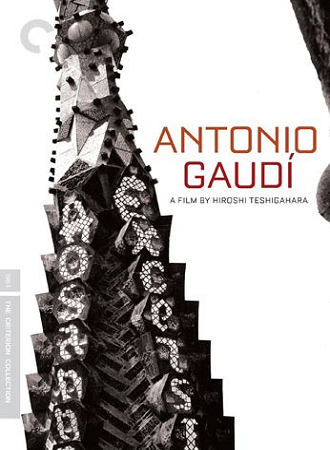
Antonio Gaudi 1984
Distributed by Milestone Film & Video, 275 W. 96th Street, Suite 28C, New York, NY 10025
Produced by Hiroshi Teshigahara
Director n/a
VHS, color, 72 min.
High School - Adult
Art, Architecture
Date Entered: 11/09/2018
Reviewed by Cara List, Architecture and Allied Arts Library, University of OregonFilmmaker Hiroshi Teshigahara’s visual love affair with the fantastic architecture of Antonio Gaudi (1852-1926) is a film not to be merely watched but to be experienced. The virtually wordless soundtrack of Antonio Gaudi allows the viewer to be submerged in the slow-moving camera work of cinematographers Junichi Segawa, Ryu Segawa and Yoshikazu Yanagida. The compelling cinematography captures what no book possibly could-- a sense of the space and movement in Gaudi’s structures. Even a personal tour of these buildings could not provide the close-up examination of surface and texture juxtaposed with sweeping vistas of Barcelona and birds-eye views of the architect’s impact upon the city.
Antonio Gaudi sought to create an architecture that complimented and reflected natural forms. He once noted that “God’s architecture” contains no straight lines. This organic quality is emphasized by the movement of the camera around and through the architecture. As the film opens, the viewer is exposed to the architecture of several of Gaudi's contemporaries in late 19th century Catalan. The blinking eye of the camera lights upon the flat façade of the Casa Amatller by Josep Puig y Cadafalch before giving way to a fluid pan over the almost human shapes of Gaudi's Casa Batllo. The anthropomorphic curves of the building's foyer are further emphasized by the cinematographer's attention to the spine-like edge of the stairwell. Absorbed in the quiet appreciation of a smoothly molded ceiling, the viewer finds the sudden appearance of people occupying the room below disconcerting and almost rude.
Equally startling is the sound of a conversation between a student and Professor Juan Bassegoda Nonell, a noted Gaudi scholar. The moment is one of only a few in which human voices intrude upon the mesmerizing score by film composer Toru Takemitsu. The complete lack of narration and the minimal subtitles force the viewer to consider the architecture for what it is without the usual stream of labels and comparisons. The filmmaker’s acute sensual appreciation for the tiniest details is reflected in the meditative quality of the musical score. At other times the ethereal, almost spooky music seems at odds with such profoundly earthy forms as Gaudi’s grottos at the Parque Guell.
Gaudi’s master work, the Sagrada Familia is the final structure explored in the film. The complexity of Gaudi’s plan for this structure has been a slowly unfolding puzzle to architects who have carried on his work since his untimely death in 1926. This segment of the film is the only portion to have any narration which comes in the form of a commentary by Puig Boada, Gaudi’s assistant in the construction of the temple. Boada explains that the model for the temple was destroyed in the Spanish Civil War, and many architects have since been involved in researching and recreating the plan for this ultimate expression of Gaudi’s artistic genius. The temple was still incomplete on the recent 150th anniversary of Antonio Gaudi’s birth. Boada tells the viewer that Gaudi wanted architecture to be in the image of nature, and this film is a wonderful testament to his effort and achievement.
Because this film is primarily a visual experience of Gaudi’s architecture, the viewer may wish to consult George Roseborough Collins’ short but important work Antonio Gaud, George Braziller, 1960. Several more recent publications include Rainer Zerbst’s Gaudi, 1852-1926: Antoni Gaudi i Cornet: a life devoted to architecture, Taschen, 1991, and Antonio Gaudi: Master Architect by Juan Bassegoda Nonell, Abbeville Press, 2000. A compliment to the visual feast of the film can be found in The Designs and Drawings of Antonio Gaudi, by an unbeatable partnership of two notable Gaudi scholars: Juan Bassegoda Nonell and George Roseborough Collins, Princeton University Press, 1983. Most of Gaudi’s drawings were destroyed by the same Civil War fire that destroyed the model of Sagrada Familia, so those that survive provide a valuable insight to the intellect of the architect. The architect’s complex spatial engineering illustrated in The Designs and Drawings of Antonio Gaudi is an excellent compliment to the sensual celebration that is Teshigahara’s Antonio Gaudi.